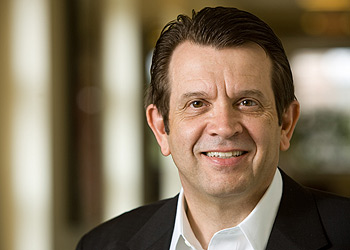Wake Forest to use WebEx solutions

Professor Steve Nickles said, "WebEx is so easy to use and so reliable that the possibilities for how students and faculty might implement the technology are endless."
With the click of a mouse, it is possible to connect with anyone, anywhere in the world. In a matter of seconds, you can see them, speak to them, and share a document to make simultaneous contributions. Forward-thinking university professors have been using these online tools to enhance students’ learning for years, but the stories of transformative learning experiences have been isolated to individual classes, project teams, or academic departments. Unreliable technology, poor video quality, and risky security have limited widespread collaboration.
Wake Forest and Cisco are working together to transform the way students, faculty, and staff members interact with each other and with collaborators around the world. Wake Forest will be the first university in the world to unite every member of the extended campus community with a site-wide license for Cisco WebEx Meeting Center.
“There is a network-effect with Collaboration—the more people that adopt a common platform when they communicate and collaborate, the greater the impact. Wake Forest has demonstrated real innovation when rethinking the education model,” said Carl Wiese, vice president, Global Collaboration Sales at Cisco. “By adopting a leading-edge technology solution that is standard across the entire campus, they’re not only simplifying the implementation of that solution, but they’re also enhancing the experience for their educators, students and administration staff.”
“The pervasiveness of this technology on campus will allow professors to plan differently for how they conduct classes. We expect to identify ways to use WebEx that have never even been considered before,” said Rick Matthews, Wake Forest’s Chief Information Officer. “When Wake Forest was the first university in the country to adopt a policy of providing laptop computers to every student, it was a groundbreaking experiment in using technology to enhance a student’s learning experience. I expect the adoption of WebEx to produce even greater benefits as we weave it into the fabric of the university.”
The desire to increase collaboration drove the University’s search for a technology solution, Matthews explained. “We needed a platform that could amplify the teaching and learning taking place in the classroom to link students and researchers to experts across campus and across the globe.” The WebEx functions include high-quality video, file transfer, chat and voice conferencing; session recording, desktop sharing, application sharing and a virtual whiteboard. “WebEx makes WFU professors and students more accessible to each other, going beyond the brick and mortar buildings to provide new avenues for learning,” Matthews said.
 During a six-month pilot program from May to October 2010, early adopters of the WebEx technology included a traveling faculty member who conducted a class that would normally have been cancelled, a class of MBA students who were able to collaborate on group assignments outside of class, and a law professor who is exploring new and creative uses of WebEx tools.
During a six-month pilot program from May to October 2010, early adopters of the WebEx technology included a traveling faculty member who conducted a class that would normally have been cancelled, a class of MBA students who were able to collaborate on group assignments outside of class, and a law professor who is exploring new and creative uses of WebEx tools.
Steve Nickles is among the most enthusiastic members of the initial WebEx user community at Wake Forest. The C. C. Hope Chair in Law and Management teaches courses in Wake Forest’s law school, business school and divinity school. “In the classroom, I tend to be more traditional,” Professor Nickles said. “A blackboard and chalk are my principle teaching tools but I want to use technology so that my students can reach me when we are not in class. I love the way technology enhances my ability to interact with students regardless of my location.”
During the pilot phase, Professor Nickles used WebEx to meet with students during office hours and to facilitate discussions between his class and external experts. “With WebEx, two federal judges in different states were able to speak to my class simultaneously while sharing decision briefs and legal opinion documents on the students’ desktops. The judges were able to participate only because the WebEx Meeting Center session was securely delivered through the Cisco Collaboration Cloud.”
When Professor Nickles was asked by another federal judge about the possibility of providing student interns last semester, he immediately thought of the options made possible by WebEx. Professor Nickles made arrangements for one of his students to work as a federal judicial clerk without ever leaving Wake Forest’s campus. The student was able to meet with the judge on a regular basis and even witness hearings through WebEx.
“WebEx is so easy to use and so reliable that the possibilities for how students and faculty might implement the technology are endless,” said Professor Nickles.
These examples of collaboration and many other stories of successfully connecting members of the Wake Forest community during the six-month pilot period led to a faculty-driven decision to embrace the virtual video conferencing experience that WebEx Meeting Center provides with high-quality video. Wake Forest administrators have realized that WebEx Meeting Center perpetuates, not hinders, the University’s value of personal interaction between faculty and students.
Provost Jill Tiefenthaler is excited about the ability of WebEx to support the university’s strategic priorities. “Collaboration technology enhances Wake Forest’s intellectual assets and global relationships,” she said. “With WebEx we can attract faculty from all over the world, we can increase the diversity of ideas to which our students are exposed, and our students will be proficient with technology they can apply in future professional pursuits.”
Provost Tiefenthaler recognizes the challenges of layering technology solutions on top of an academic model that prides itself on personal connections between and among faculty and students. “Wake Forest has several things in its favor that will increase our chance of success. This was a technology initiative driven from the ground level, it has the support of senior leadership, and we are going to make it as easy as possible to use. When combined with the campus-wide scale of implementation, I think we have created the prime conditions to empower a transformative movement in how our faculty teaches and our students learn.”
Wake Forest will conduct a campus-wide rollout over the remainder of the spring semester with a new program designed to accelerate and support faculty adoption of collaborative technologies. When students return to campus for the fall 2011 semester, WebEx tools will be accessible and supported on an ongoing basis.



